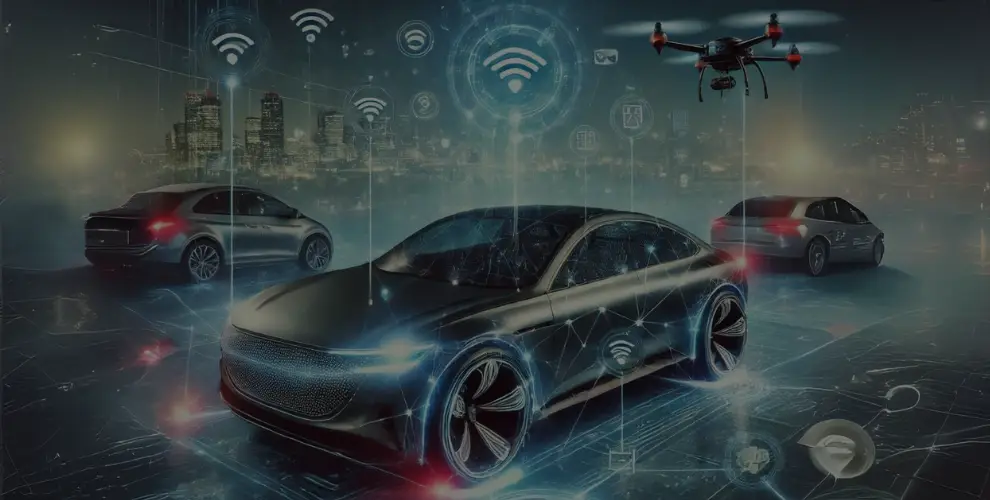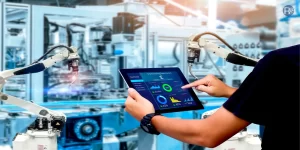
IoT in the Automobile Industry: Driving Incredible Innovation
Table of Contents
Introduction:
Welcome to WikiGlitz!
We’ve brought you this amazing blog about IoT in the automobile industry and how it’s reshaping the future of transportation.
The Internet of Things (IoT) is driving groundbreaking innovations across the automotive sector, from enhancing vehicle safety and efficiency to enabling autonomous driving and smarter transportation systems.
In this article, we’ll explore how IoT is applied in the automobile industry, its benefits, challenges, and its potential to transform the way we drive and interact with vehicles.
Key Takeaways
- IoT in the automobile industry enhances safety, efficiency, and innovation by enabling connected vehicles, smart transportation systems, and autonomous driving.
- Examples of IoT in automobiles include vehicle-to-everything (V2X) communication, IoT-enabled diagnostics, and predictive maintenance systems.
- Despite challenges like data security and infrastructure costs, the impact of IoT on the automotive sector is far-reaching, driving advances in electric vehicles, autonomous cars, and smart cities.
How is IoT Used in the Automobile Industry?
IoT in the automobile industry refers to the network of sensors, devices, and software that allows vehicles to communicate with each other, infrastructure, and the cloud.
This real-time data exchange enhances vehicle functionality, safety, and the overall driving experience. But how is IoT used in the automobile industry exactly?
Some common applications include:
- Connected cars: IoT enables vehicles to connect to the internet, allowing drivers to access navigation, entertainment, and safety features remotely. For example, cars can update their software automatically or provide real-time traffic information.
- IoT-enabled car diagnostics: Sensors embedded in various components of the vehicle monitor performance and notify the driver of any issues before they become serious problems.
- Vehicle-to-everything (V2X) communication: This allows cars to communicate with each other, traffic signals, and even pedestrians to optimize traffic flow and reduce the risk of accidents.
In short, IoT turns cars into “smart” machines capable of responding to real-time data and conditions, making driving more efficient and safer.
What is the Impact of IoT on the Automotive Sector?
The impact of IoT on the automotive sector is vast, ranging from improved safety features to autonomous driving.
IoT has disrupted traditional car manufacturing by introducing technologies that allow vehicles to act intelligently and autonomously. Listed are some of the impacts:
- Increased vehicle safety: IoT allows cars to anticipate and avoid collisions by communicating with other vehicles and infrastructure. Sensors can also monitor road conditions and provide real-time feedback to the driver.
- Smart transportation systems: IoT is playing a key role in developing smart cities by integrating vehicles with urban infrastructure to reduce congestion and optimize traffic management. Connected vehicles can interact with traffic lights, toll booths, and parking systems.
- Autonomous vehicles: IoT is the backbone of self-driving cars, where real-time data from sensors enables the vehicle to “see” its surroundings and make driving decisions without human intervention.
As IoT technology advances, its influence on the automobile industry will only continue to grow, paving the way for fully autonomous, connected, and smarter vehicles.
What Are Some Examples of IoT in Automobiles?
There are numerous examples of IoT in automobiles that illustrate its growing role in the automotive sector. Some of these include:
- IoT for autonomous vehicles: Self-driving cars rely heavily on IoT to sense their surroundings and make driving decisions. Advanced sensors gather data in real-time, allowing these vehicles to operate without human input.
- IoT in electric vehicles: IoT is instrumental in managing electric vehicles (EVs), optimizing battery performance, monitoring charging patterns, and even locating nearby charging stations.
- IoT-enabled car diagnostics: Cars equipped with IoT sensors can provide predictive maintenance by monitoring the condition of various parts and alerting the driver when maintenance is needed.
- Connected cars and IoT solutions: Vehicles now come with connectivity features that allow drivers to control aspects of the car, like locking doors or checking fuel levels, through smartphone apps.
These examples show how IoT is already revolutionizing the automobile industry, creating smarter, safer, and more efficient vehicles.
How Does IoT Improve Vehicle Safety?
One of the most important contributions of IoT in the automobile industry is its ability to improve vehicle safety.
How does IoT improve vehicle safety? IoT enhances safety by integrating sensors, cameras, and communication systems that work together to prevent accidents and protect passengers. Some specific ways include:
- Collision avoidance: IoT sensors can detect obstacles in the vehicle’s path and either warn the driver or automatically apply the brakes to prevent a collision.
- Driver assistance systems: IoT-powered systems like lane-keeping assistance and adaptive cruise control help drivers maintain control of their vehicles, even in challenging conditions.
- Emergency services integration: In the event of an accident, IoT can automatically notify emergency services, providing the vehicle’s location and details of the incident.
These safety features, made possible by IoT, greatly reduce the chances of accidents and enhance the overall security of passengers.
How Does IoT Drive Innovation in the Automotive Industry?
IoT is the foundation for many of the innovations we see in modern vehicles, including autonomous driving, connected cars, and enhanced vehicle diagnostics.
Some key areas where IoT is driving innovation include:
- Autonomous driving: IoT enables self-driving cars by providing the data and communication networks necessary for these vehicles to operate independently. Real-time data from IoT sensors helps the car understand its environment and make driving decisions.
- Electric vehicles (EVs): IoT is critical in EVs for managing energy consumption, monitoring battery performance, and optimizing the charging process. This helps extend battery life and improves the overall efficiency of electric vehicles.
- Predictive maintenance: IoT-enabled car diagnostics allow manufacturers to predict when parts will fail, enabling preventative maintenance that reduces the likelihood of breakdowns and costly repairs.
IoT is not just driving incremental improvements; it is reshaping the entire landscape of the automotive industry, making cars smarter, safer, and more efficient.
What Are the Benefits of IoT in Connected Cars?
There are numerous benefits of IoT in connected cars that improve both the driving experience and vehicle maintenance:
- Enhanced safety: IoT enables advanced driver assistance systems (ADAS) that include features like automatic braking, lane departure warnings, and real-time traffic updates to reduce accidents.
- Predictive maintenance: IoT sensors continuously monitor vehicle health, identifying issues early to prevent costly repairs and ensure the car runs efficiently.
- Optimized driving: IoT helps optimize fuel consumption by providing real-time traffic data and suggesting efficient routes.
These benefits make IoT essential for creating the next generation of connected, efficient, and user-friendly cars.
What Are the Challenges of Implementing IoT in the Automobile Industry?
While the potential for IoT in the automobile industry is vast, it comes with challenges. Some of the major challenges of implementing IoT in the automobile industry include:
- Data security: With cars becoming increasingly connected, protecting user data from cyberattacks is a significant challenge. IoT systems must be designed with robust encryption and security protocols to safeguard sensitive information.
- Infrastructure costs: Implementing IoT systems in vehicles requires a supporting infrastructure, such as 5G networks and smart city systems, which can be costly to develop.
- Technical integration: Incorporating IoT into vehicles requires coordination between automakers, tech companies, and governments to create seamless, integrated systems that work efficiently.
Despite these challenges, the benefits of IoT in the automotive sector far outweigh the obstacles, making it a vital technology for the future of transportation.
Conclusion
In this article, we’ve explored the exciting world of IoT in the automobile industry and how it is revolutionizing the way we drive and interact with cars.
From improving vehicle safety and enabling autonomous driving to transforming electric vehicles, IoT is at the forefront of innovation in the automotive sector.
As IoT continues to evolve, its role in creating smarter, safer, and more connected vehicles will only grow. Follow WikiGlitz for more insights into the latest trends in technology and innovation!
FAQs
How is IoT used in the automobile industry?
IoT enables vehicles to connect to other devices, infrastructure, and networks to improve safety, navigation, and vehicle diagnostics. It powers connected cars, autonomous vehicles, and smart transportation systems.
What are some examples of IoT in automobiles?
Examples include IoT-enabled diagnostics, autonomous driving systems, connected car features like remote control via apps, and V2X communication.
How does IoT improve vehicle safety?
IoT enhances safety through collision avoidance systems, driver monitoring for fatigue, and automatic emergency response in case of accidents.
What are the benefits of IoT in connected cars?
Key benefits include enhanced safety, predictive maintenance, optimized fuel efficiency, and real-time navigation updates.
What challenges exist in implementing IoT in the automobile industry?
Challenges include ensuring data security, developing the necessary infrastructure, and the cost of integrating IoT systems into vehicles.
How does IoT contribute to smart transportation systems?
IoT helps create smarter transportation systems by enabling real-time traffic management, improving road safety, and integrating vehicles with urban infrastructure for more efficient mobility.
Want to keep up with our blog?
Our most valuable tips right inside your inbox, once per month.
Error: Contact form not found.
WikiGlitz Team
Welcome to WikiGlitz, your ultimate destination for tech insights and innovation. Our expert team is dedicated to delivering free resources and professional advice on various technology topics, including Artificial Intelligence, Cyber Security, Cloud Computing, and more. We strive to empower our readers with up-to-date information and practical guidance, ensuring you stay ahead in the rapidly evolving tech landscape. At WikiGlitz, we are passionate about making complex technology accessible to everyone. Our team of seasoned experts curates content that is both informative and engaging, helping you understand and leverage the latest tech trends. Whether you're a tech enthusiast or a professional, WikiGlitz is your go-to source for reliable, expert-driven content. Join us on this journey to explore and embrace the future of technology.





